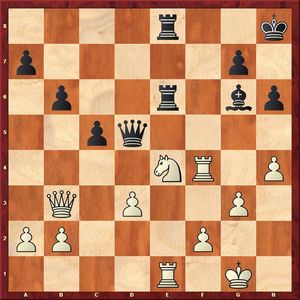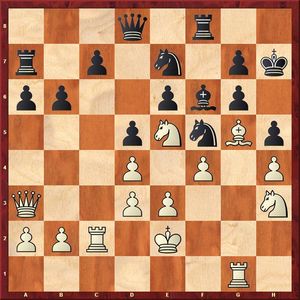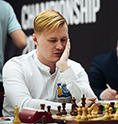23 May 2015
To err is human
Vladimir Barsky reviews the 8th round of the FIDE Grand Prix.
Natalia Komarova, the Governor of Ugra, visited the final stage of the FIDE Grand Prix in Khanty-Mansiysk together with a delegation from Finland today. Jari Salonen, chairman of the Regional Council of Päijät-Häme, was leading the delegation. Together with the Governor they visited the playing hall to follow the games live. Then Natalia Komarova showed the guests a class where young students of the Academy study chess. The guests also visited the commentary room and a computer class. Your correspondent asked Jari Salonen when Finland will start organizing major chess tournaments and perhaps even grow their own World Champion, like their Norwegian neighbors. He responded: “We should get better in hockey first!”
Jari Salonen and Natalia Komarova
Vachier-Lagrave-Giri draw
The French grandmaster decided to play very safely after the four straight losses. He did not push the g-pawn (in the previous White games he played g4 whenever possible), castled short, and took care about developing his pieces. Anish Giri said line of the Anti-Meran that occurred in the game was introduced by Vishy Anand, but Vachier-Lagrave corrected him: no, this plan was invented by Alexander Beliavsky. We should believe Maxime in this matter, because the four-time USSR champion is his coach and clearly showed the student all ideas behind this setup.
As it often happens in this variation, Black sacrificed a pawn, but simplified the position greatly. The key question was whether White manages to get some kind of a positional advantage while Black will be regaining the pawn. The Dutch grandmaster skilfully avoided trouble, and the players agreed to a draw on the 32nd move.
Anish Giri and Maxime Vachier-Lagrave
Vachier-Lagrave said he wanted to play with minimal risk. Anish Giri also did not want to go all out for a win only because his opponent just lost four games in a row: Maxime is Maxime, he can strike any time!
Having finished the postmortem analysis of their game, the players stayed at the press-center and unhurriedly examined other games of the round. They concluded that all of them are going to be very tense and exciting. “It is good for spectators, and perhaps they will forgive our short draw!”, said Anish.
Grischuk-Karjakin 1-0
Alexander Grischuk and Sergey Karjakin
The leaders of the Russian national team played a very exciting game, featuring a very rare and sharp line of the Slav Defense. Grischuk said he hoped his opponent will think for half an hour after 10.е5, which is a rare continuation, but Karjakin responded very quickly by exchanging knights.
In the resulting non-standard position both sides had pluses and minuses. Black had a protected passed pawn on d3, but his king was insecure, White had an extra pawn, but his bishop was passive. Both played very well, showing great resourcefulness and skill, but in the harsh time trouble Karjakin made a big blunder on the 39th move and resigned immediately. According to the machine, after the correct response the very sharp position would remain dynamically balanced.

In this position Black played 39...Nf7?? (39...Kh6!) and resigned after 40.Qg8!
Caruana-Jakovenko 0-1
In the Anti-Berlin White got a very promising position and won a pawn. Black had certain compensation, as the extra pawn on d3 was weak and required protection. However, soon Caruana suddenly lost the thread of the game. He got too attached to the d3-pawn and even brought his rook to f3, where it was placed very awkwardly. Jakovenko managed to put a pawn on c5, fixing the opponent's weakness, and organized a pin on the e-file, neutralizing White's centralized knight.
Dmitry Jakovenko and Fabiana Caruana
Caruana realized that he lost an advantage and offered a queen trade on the 36th move. If Black accepted it, White's pawn structure would be completely ruined. However, this move was a bad blunder made under time pressure: Black's tactical reply с5-с4 gave him an extra pawn and an overwhelming positional advantage. The white king got under mating attack, and after the time control the tournament leader resigned.

After White's 36th move
Jobava-Nakamura 0-1
Two creative players produced a real thriller. The Veresov Opening is not often played in major events, but even there Baadur introduced a very rare plan. On the 11th move White sacrificed a pawn; Jobava said the sacrifice is interesting, Nakamura considered it dubious.
In a completely non-standard position all pieces including kings were involved in a battle. Grandmasters Sergey Rublevsky and Sergey Shipov said that sometimes they could not even guess the right flank where the next move will be made!
Hikaru Nakamura and Baadur Jobava
Jobava was first to make major mistakes; at the press-conference he called 27.b4 and 28.Qc3 “two stupid moves”, as he completely missed Black's reply 28…с6. Black carried out а6-а5, and White's queenside was ruined. The Georgian grandmaster did not give up in a difficult situation, and created a dangerous attack on the enemy king almost out of nowhere.

After Black's 26th move
Nakamura found the way to defend and kept two extra pawns, but White's pieces were very active, and converting the advantage was rather problematic. However, when a draw seemed within reach, Jobava made another mistake by sending his king to e7. Nakamura immediately gave up one pawn, transposing to an easily won rook ending with the white king cut off. The rest was a matter of simple technique.
Gelfand-Svidler 1-0
Peter Svidler and Boris Gelfand
Peter Svidler misplayed a popular theoretical variation of the Gruenfeld Defense and got a hopeless position already by the 18th move. In addition, he had this evaluation written down on his computer! Svidler said he may explain his decision to enter that line step by step, but, according to the Russian, it would be more interesting for a psychiatrist, not a chess fan.

After White's 18th move
In a critical position Black found the only move, which did not lose on the spot – 18…Nf8. White's position remained dominant, but Boris Gelfand was probably overwhelmed by variety of promising options, lost the right track and gave away a lion's share of his advantage. Having almost made a draw, Svidler began to err again, allowing White to block the kingside, creating dangerous threats. And even after that Black could probably survive, but...
“Trading the f7-pawn for g5-pawn is the most stupid decision, an act of complete madness. This is not my best game, and Boris also could win much easier and quicker”, concluded Svidler.
Gelfand smiled and quoted the Latin proverb: Errare humnnum est, to err is human.
Tomashevsky-Dominguez draw
This game lasted almost seven hours and ended last. Tomashevsky demonstrated a novelty that he invented himself, but unfortunately forgot the correct move order. Therefore he had to consume a lot of time, which was badly needed later in the game to convert White's advantage.
Facing the Gruenfeld Defense, White sacrificed an exchange, obtaining two strong central pawns. After lengthy thought Black returned an exchange, winning back one of the pawns, and transposed to an endgame with opposite-colored bishops, According to Tomashevsky, this was not a wise choice, and the game continued with only two results possible and with rather big winning chances for White. However, even in the postmortem the players were unable to find a clear-cut way to White's victory. Lenier Dominguez defended stubbornly and saved half a point on the 101st (!) move.
Lenier Dominguez and Evgeny Tomashevsky
* * *
Standings after 8 rounds: 1-3. Dominguez, Caruana, and Nakamura – all 5, 4-6. Gelfand, Karjakin, and Jakovenko – all 4.5, 7-8. Grischuk and Svidler – both 4, 9. Giri – 3.5, 9-10. Jobava and Tomashevsky – both 3, 12. Vachier-Lagrave – 2.






















